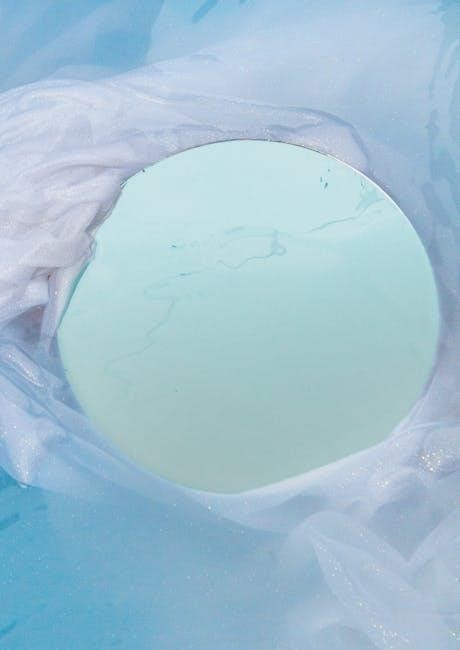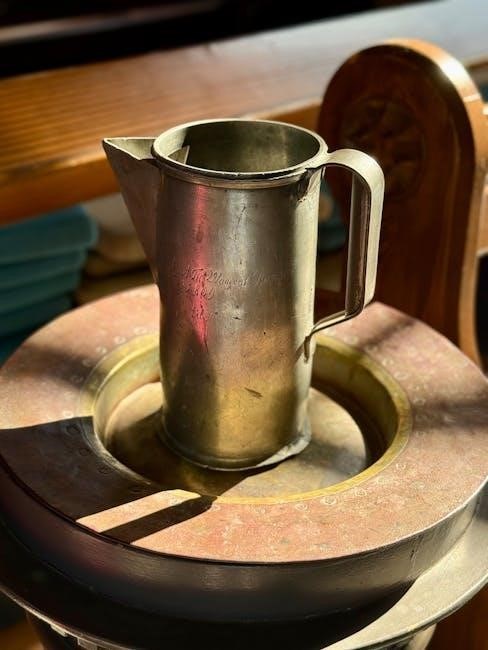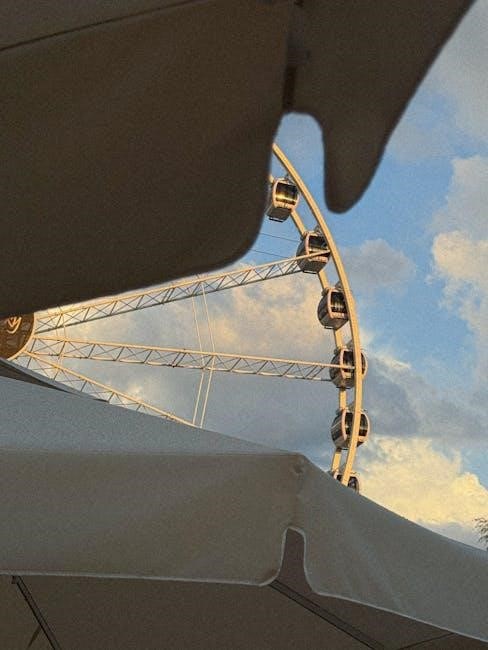Understanding the Circumference of a Circle
The circumference of a circle is the distance around its edge‚ equivalent to its perimeter. It is calculated using the formula C = 2πr or C = πd‚ where r is the radius and d is the diameter. The value of π (approximately 3.14) is central to these calculations‚ representing the ratio of circumference to diameter. Understanding circumference is fundamental in geometry and real-world applications‚ such as measuring circular objects or determining distances in wheels or pools.
1.1 Definition of Circumference
The circumference of a circle is defined as the distance around the edge of the circle. It is the equivalent of the perimeter for other shapes‚ such as triangles or rectangles‚ but specifically applies to circular forms. The circumference is measured in linear units‚ such as inches‚ feet‚ or meters‚ and it represents the total length required to go around the circle once. For example‚ if you were to lay a string along the edge of a circular object and then measure the length of the string‚ that measurement would be the circumference of the circle.
The concept of circumference is closely tied to the fundamental properties of a circle‚ including its radius and diameter; The radius is the distance from the center of the circle to any point on its edge‚ while the diameter is the distance across the circle through its center‚ which is twice the radius. Understanding the relationship between these elements is essential for calculating and working with the circumference of a circle.
Circumference is a critical concept in geometry and has numerous practical applications‚ such as determining the distance around a circular tabletop or the length of a wheel’s edge. It also plays a key role in calculations involving area‚ as the two are mathematically connected through the formula C = 2πr or C = πd‚ where C is the circumference‚ r is the radius‚ and d is the diameter.
By mastering the definition and properties of circumference‚ students can better understand how circles function in various real-world scenarios‚ from engineering to everyday measurements. Worksheets and practice problems often focus on this foundational concept to build a strong understanding of circular geometry.
1.2 Formula for Circumference
The circumference of a circle can be calculated using two fundamental formulas. The first formula is C = 2πr‚ where C is the circumference‚ r is the radius of the circle‚ and π is a constant approximately equal to 3.1416. The second formula is C = πd‚ where d is the diameter of the circle. Both formulas yield the same result since the diameter is twice the radius (d = 2r).
These formulas are essential in geometry and are widely used in various applications‚ such as calculating the distance around a circular object or determining the length of a circular path. For example‚ if a circle has a radius of 4 cm‚ its circumference would be C = 2π(4) = 8π cm‚ or approximately 25.13 cm. Similarly‚ if the diameter is 10 cm‚ the circumference would be C = π(10) = 10π cm‚ or about 31.416 cm.

Worksheets often include problems that require applying these formulas to find the circumference when given the radius or diameter. They also help students understand the relationship between the circle’s dimensions and its perimeter. Regular practice with these formulas ensures mastery of the concept and its practical applications in real-world scenarios.
1.3 Practical Examples and Problems
Practical examples and problems are essential for understanding how to apply the concept of circumference in real-world scenarios. For instance‚ if a circular tabletop has a radius of 1.9 feet‚ its circumference can be calculated using the formula C = 2πr‚ resulting in approximately 11.92 feet. Similarly‚ a circular window with a diameter of 25 inches would have a circumference of about 78.54 inches.
Worksheets often include a variety of problems‚ such as:
- Calculating the circumference of a circle when given the radius or diameter.
- Finding the radius or diameter when the circumference is provided.
- Solving word problems‚ such as determining the distance traveled by a bicycle wheel in one full rotation.
- Calculating the circumference of a semicircle or other partial circles.
For example‚ if a truck wheel has a diameter of 56.5 inches‚ its circumference would be C = π × 56.5‚ which is approximately 177.25 inches. Another problem might involve a clock with a minute hand of 13.8 meters‚ where the circumference of the clock face would be C = 2π × 13.8‚ resulting in about 86.77 meters.
These problems help students master the concept of circumference and its practical applications‚ ensuring they can solve real-world math challenges with confidence.

1.4 Significance of Pi (π) in Circumference
The significance of Pi (π) in calculating the circumference of a circle lies in its role as a fundamental constant. Pi is approximately 3.14159 and represents the ratio of a circle’s circumference to its diameter. This relationship‚ expressed as C = πd or C = 2πr‚ shows that Pi is essential for determining the circumference when the diameter or radius is known.
Pi is an irrational number‚ meaning its decimal representation never ends or repeats‚ which is why it is often approximated as 3.14 in calculations. The use of Pi ensures accuracy in various applications‚ from engineering to everyday measurements. For example‚ in problems involving circular objects like wheels or pools‚ Pi allows precise calculations of distances or material requirements.
Worksheets often emphasize the importance of Pi by incorporating it into exercises. Students learn to apply Pi in formulas‚ rounding it to 3.14 for simplicity. This practice helps in solving problems like finding the circumference of a circle with a given diameter or radius‚ ensuring a solid understanding of its role in geometry.

This worksheet provides exercises to calculate the circumference of circles using the diameter or radius. It includes problems of varying difficulty‚ answers for self-assessment‚ and uses different measurement units. Perfect for practice‚ it’s free to download in PDF format for easy printing.
2.1 Overview of the Worksheet
The Circumference of a Circle Worksheet with Answers PDF is a comprehensive resource designed to help students master the concept of calculating a circle’s circumference. It contains a variety of problems that cater to different skill levels‚ from basic to advanced‚ ensuring a gradual learning curve. The worksheet includes exercises where students are given either the radius or diameter of a circle and must apply the formula C = 2πr or C = πd to find the circumference. Some problems also involve real-world applications‚ such as calculating the distance around a circular tabletop or the circumference of a wheel‚ making the practice more engaging and relevant.
Each problem is followed by its solution‚ allowing students to check their work and understand where they might have gone wrong. The worksheet is structured to reinforce the relationship between a circle’s radius‚ diameter‚ and circumference‚ while also emphasizing the importance of unit conversions and precise calculations. Additionally‚ the PDF format makes it easy to download and print‚ providing a convenient tool for classroom or home study. This resource is particularly useful for educators seeking to supplement their lesson plans with engaging and effective practice materials.
2.2 Benefits of Using Worksheets
Using a Circumference of a Circle Worksheet with Answers PDF offers numerous benefits for students and educators alike. These worksheets provide structured and organized practice‚ helping students develop a strong understanding of how to calculate the circumference of a circle. By working through various problems‚ students can master the application of formulas like C = 2πr and C = πd‚ building both accuracy and speed. Worksheets also allow for self-assessment‚ as students can compare their answers with the provided solutions‚ identifying and correcting mistakes independently.
Another advantage is the ability to cater to different learning levels. Worksheets often include problems of varying difficulty‚ ensuring that students can progress from basic calculations to more complex‚ real-world applications. This gradual approach helps reinforce concepts and prepares students for higher-level math. Additionally‚ worksheets like these are easily accessible and printable‚ making them a convenient tool for both classroom instruction and home study. By using these resources‚ students can practice regularly‚ improving their problem-solving skills and confidence in geometry.
2.3 Different Levels of Difficulty
Circumference of a Circle Worksheets with Answers PDF are designed to accommodate students of various skill levels‚ ensuring that learning is accessible and effective for everyone. These worksheets typically start with basic problems that involve straightforward calculations‚ such as finding the circumference when the radius or diameter is provided. For example‚ problems might ask students to calculate the circumference using simple values like 2cm or 14m‚ allowing them to grasp the fundamental application of the formula C = 2πr or C = πd.
As the difficulty increases‚ the problems introduce more complexity‚ such as calculating the circumference for real-world objects like truck wheels or clock hands. Some worksheets also incorporate unit conversions‚ requiring students to switch between inches‚ feet‚ meters‚ or miles‚ which adds an extra layer of challenge. Advanced problems might involve calculating the radius or diameter when the circumference is given‚ reinforcing the inverse relationship between these measurements.
By offering a range of difficulty levels‚ these worksheets help students progress from basic understanding to more complex applications‚ ensuring a comprehensive mastery of the concept. This structured approach allows educators to tailor lessons to the needs of their students‚ providing a smooth transition from foundational skills to advanced problem-solving.

2.4 Measurement Units in Worksheets
Measurement units play a crucial role in Circumference of a Circle Worksheets with Answers PDF‚ as they help students understand the practical applications of the concept. These worksheets often include problems with various units‚ such as inches‚ feet‚ yards‚ miles‚ centimeters‚ meters‚ and kilometers. This variety allows students to become familiar with different measurement systems and conversions‚ enhancing their problem-solving skills.
For instance‚ one problem might ask for the circumference of a circular tabletop with a radius of 1.9 feet‚ while another might involve a clock hand measuring 13.8 meters. Such diversity ensures that students learn to apply the formula C = 2πr or C = πd across different contexts and units. Additionally‚ some worksheets include problems where the answer must be rounded to a specific decimal place‚ teaching precision and accuracy in calculations.
By incorporating multiple measurement units‚ the worksheets prepare students for real-world scenarios where units may vary. This comprehensive approach ensures that students not only master the mathematical aspect of calculating circumference but also develop an understanding of how these calculations apply to everyday situations‚ making the learning process both engaging and practical.
2.5 Downloading the PDF
Circumference of a Circle Worksheets with Answers PDF are readily available for download‚ providing students and educators with a convenient resource for practice and assessment. These PDFs are designed to be user-friendly and accessible‚ often free of charge‚ and can be found on various educational websites like mathworksheets4kids.com and corbettmaths.

The worksheets are typically formatted in clear‚ printable layouts‚ making them ideal for classroom use or homework assignments. Many PDFs include answer keys‚ allowing students to self-check their work and understand where they might have gone wrong. This feature is particularly helpful for independent study and reinforces learning.
Some worksheets also offer editable versions‚ enabling teachers to tailor problems to specific needs or levels of difficulty. Additionally‚ the PDFs often cover a range of measurement units‚ such as inches‚ feet‚ meters‚ and centimeters‚ catering to diverse educational standards and student proficiency levels.
To download‚ simply visit the respective websites‚ navigate to the worksheet section‚ and select the desired PDF. Ensure that the file includes both the problems and answers for a comprehensive learning experience. These resources are invaluable for mastering circumference calculations in a structured and engaging manner.

Applications of Circumference
Circumference is essential in real-world applications like engineering‚ architecture‚ and everyday measurements. It helps determine distances for wheels‚ pools‚ and circular structures. Understanding circumference aids in calculating lengths for fencing‚ borders‚ and circular paths‚ making it a practical skill in various industries and daily tasks.
3.1 Real-World Examples
Circumference calculations are widely used in various real-world scenarios. For instance‚ determining the circumference of a circular tabletop helps in measuring its edge length‚ which is essential for fitting tablecloths or understanding its size. Similarly‚ knowing the circumference of a truck wheel allows calculation of the distance it covers in one rotation‚ which is crucial for speedometer calibrations and mileage tracking. Farmers use circumference to measure the perimeter of circular fields for fencing purposes‚ ensuring accurate material measurements. Architects and engineers apply circumference calculations to design circular structures‚ such as roundabouts or pillars‚ ensuring precise dimensions. In everyday life‚ measuring the circumference of a clock’s minute hand helps calculate the distance it travels over time. Additionally‚ the circumference of a circular pool or fountain is necessary for installing liners or decorative borders. These examples highlight how understanding circumference is not just theoretical but has practical applications in construction‚ transportation‚ agriculture‚ and more.
- Circular tabletops and windows require circumference measurements for sizing and material fitting.
- Truck wheels’ circumference is used to calculate distance traveled per rotation.
- Farmers use circumference to measure circular fields for fencing.
- Architects apply circumference in designing roundabouts and circular structures.
- Circumference helps determine the distance traveled by a clock’s minute hand.
- Pool and fountain circumferences are essential for installing liners or borders.
These examples demonstrate the versatility and importance of circumference in solving real-world problems.
3.2 Calculating Circumference for Different Shapes
While the term “circumference” is most commonly associated with circles‚ similar calculations can be applied to other shapes. For example‚ the perimeter of a regular polygon‚ like a hexagon or octagon‚ can be calculated by summing the lengths of all its sides. For irregular shapes‚ the process involves measuring the total distance around the edge‚ which may require more complex methods. Even for ovals or ellipses‚ an approximation of the circumference can be made using advanced mathematical formulas‚ such as Ramanujan’s approximation. These calculations are essential in various fields‚ including engineering‚ architecture‚ and landscaping‚ where precise measurements of non-circular objects are necessary.
- For circles‚ circumference is calculated using C = 2πr or C = πd.
- For ovals or ellipses‚ circumference is approximated using complex formulas.
- For regular polygons‚ circumference is the sum of all side lengths.
- For irregular shapes‚ circumference requires manual measurement or advanced calculus;
Understanding how to calculate the circumference of various shapes enhances problem-solving skills in geometry and real-world applications‚ such as designing circular structures or measuring irregular objects. These calculations highlight the versatility of geometric principles in addressing diverse challenges.

Common Mistakes to Avoid

Common mistakes include confusing the diameter with the radius‚ using the wrong formula‚ and incorrect unit conversions. Ensure the formula C = 2πr or C = πd is used correctly. Always double-check units and calculations to avoid errors in problem-solving.
4.1 Misunderstanding the Formula
One of the most frequent errors students make when calculating the circumference of a circle is misapplying the formula. The correct formulas are C = 2πr (where r is the radius) and C = πd (where d is the diameter). However‚ many students confuse the radius and diameter‚ leading to incorrect results. For instance‚ if the diameter is provided‚ using C = 2πr without halving the diameter will double the error. Additionally‚ some students forget to multiply by π or misplace it in the formula‚ which significantly alters the outcome. Understanding that π is approximately 3.14 and is essential for accurate calculations is crucial. To avoid these mistakes‚ it’s important to carefully identify whether the given value is the radius or diameter and apply the appropriate formula. Practicing with worksheets that emphasize formula differentiation can help solidify this understanding. Moreover‚ always double-checking the units and ensuring they are consistent (e.g.‚ inches‚ centimeters) prevents further errors. By addressing these common misunderstandings‚ students can master circumference calculations with confidence.
4.2 Incorrect Unit Conversions
Incorrect unit conversions are another common pitfall when calculating the circumference of a circle. Students often mix units‚ such as using centimeters instead of meters or inches instead of feet‚ without converting them properly. For example‚ if a radius is given in centimeters but the problem requires the circumference in meters‚ failing to convert the radius to meters before calculating will result in a wrong answer. Similarly‚ mixing imperial and metric units (e.g.‚ using inches and centimeters in the same problem) can lead to confusion and errors. It is essential to ensure that all measurements are in the same unit system before applying the circumference formula. Worksheets that include problems with various unit conversions can help students practice and master this skill. Additionally‚ always double-checking the units and converting them when necessary can prevent these mistakes. By paying close attention to unit consistency‚ students can avoid errors and achieve accurate results in their calculations.

Tips for Mastering Circumference Calculations
Regular practice and understanding the relationship between radius‚ diameter‚ and circumference are key. Break problems into steps‚ ensuring correct unit conversions. Use real-world examples to apply concepts. Worksheets and guides provide structured practice‚ helping build confidence and calculation speed.
5.1 Step-by-Step Problem Solving
Mastering circumference calculations requires a systematic approach. Start by identifying whether the given value is the radius or diameter. Use the formula C = 2πr if the radius is provided‚ or C = πd for the diameter. Ensure all measurements are in the same unit before calculations. For word problems‚ visualize the scenario to understand what is being asked. Break down complex problems into smaller‚ manageable steps; Always round your final answer to a reasonable decimal place‚ as specified in the question. Practicing with worksheets helps reinforce these steps and builds confidence. Regular review of solutions allows you to identify and correct common errors‚ such as misapplying formulas or miscalculating unit conversions. By following this structured method‚ you can approach circumference problems with clarity and accuracy‚ making the process less daunting and more efficient.
- Identify the given value (radius or diameter).
- Choose the appropriate formula.
- Perform calculations step-by-step.
- Interpret and present the result clearly.
Examples and guided solutions in worksheets are invaluable for refining your problem-solving skills.
5.2 Importance of Regular Practice
Regular practice is essential for mastering circumference calculations. Through consistent exercise‚ students develop a deeper understanding of the relationship between a circle’s radius‚ diameter‚ and circumference. Worksheets play a crucial role in providing structured practice‚ allowing learners to apply formulas like C = 2πr and C = πd in various scenarios. Regular practice helps build confidence‚ as students become more comfortable with the concept and its applications. It also improves problem-solving speed and accuracy‚ reducing errors over time. Additionally‚ practicing with different levels of difficulty gradually challenges students‚ preparing them for more complex problems. Regular review of answers and solutions reinforces learning‚ ensuring that concepts are retained long-term. Furthermore‚ practice helps students recognize patterns and connections between circumference and other geometric principles‚ fostering a stronger foundation in mathematics. By dedicating time to regular practice‚ students can overcome challenges and develop fluency in calculating circumference‚ making it a valuable skill for both academic and real-world applications.
Consistent practice is the key to mastery and confidence in circumference calculations.
Mastering circumference calculations is a cornerstone of geometric literacy‚ and worksheets with answers are an excellent way to achieve this goal.
